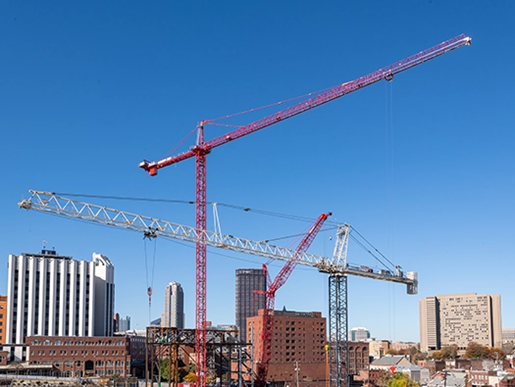
How smart material handling drives construction success
In commercial construction, budgets are tight and timelines are even tighter. Smart contractors look for any efficiency that can give them an edge without sacrificing quality. To that end, efficient material handling has emerged as a critical differentiator. On complex job sites, especially those involving structural steel, how materials are moved can significantly impact cost, safety, and schedule.
The variety of equipment needed over the duration of a construction project can be looked at as a whole and thus leveraged to create savings. We encourage general contractors and steel erectors to think about material handling as a way of maximizing savings by creating efficiencies.
Whether it’s unloading bundles of metal sheeting, precisely staging trusses, or ensuring that finishes go in without delay, the cranes, scissor lifts, and other specialized lift equipment used on-site all contribute to a smooth workflow and efficient overall project.
Efficiency equals cost savings, but safety is also vitally important. Not only is there the obvious potential human cost associated with accidents, but they can also affect downtime and productivity. Getting the right equipment from the outset is crucial.
Jobsite efficiency begins with planning
The key to efficiency isn’t just having the right tools, it’s about deploying them with precision. Contractors need an equipment team that works closely with them and tradespeople like ironworkers and sheet metal installers to plan every lift before it happens. This collaboration begins at the pre-bid and pre-work stages, where lift planning is integrated into an overall construction strategy.
Knowing which machine to use, whether a large all-terrain crane or crawler for a bundle lift or a small rough terrain crane for material staging, can determine whether you touch materials once or five times. That difference is measurable in both time and money.
One of the most overlooked aspects of material handling is how and where materials are staged. Done well, it sets the tone for a streamlined project. Done poorly, it creates congestion and inefficiencies.
Staging is an important part of productivity. If you know from experience that a crane can lift and place an entire bundle where it needs to be used, and that it won’t have to be moved again, that’s a huge win. This is where logistics tools and experience matter.
Jobsite planning includes considerations for underground utilities, overhead lines, surface obstructions, and tight site footprints. All these details influence the type of equipment needed, as well as how it should be deployed.
When trucks arrive with metal to be used on site, we consider things like the radius of particular lifting equipment, lifting capacity, and the direction material will be placed to maximize efficiency of picks and grabs while establishing the ideal working radius.
Protecting materials means protecting the budget
Construction materials like steel are expensive. Improper handling not only risks damage, but also can delay the project and rack up costs. That’s why knowledge of rigging, lift attachments, and protective handling techniques are critical.
This means using appliances like softeners, nylon straps, and specific cradling attachments when necessary. It also means knowing to elevate materials for easier access with forklifts, which avoids dragging or scraping. These aren’t afterthoughts, they should be part of the plan from the beginning.
While advancements in rigging, padded devices, and vacuum suction tools are available, equipment innovation alone doesn’t create jobsite efficiency—people do.
You shouldn’t pick equipment based on what’s new, but based on what’s right for the job. It’s about understanding what’s being lifted, the jobsite layout, and the timeline. Safety and productivity are always the top priorities.
Shared equipment programs
All these efforts—smart planning, safe lifting, efficient staging—come together in a shared equipment program (SEP). This forward-thinking strategy consolidates the lift equipment needs of a project under a single umbrella. In SEP, the general contractor serves as the primary renter, coordinating equipment use for all subcontractors.
Rather than each subcontractor renting their own lift equipment, an SEP eliminates duplication, reduces costs, and makes the jobsite safer and less congested. It’s a farsighted way of coordinating all material-handling operations.
An SEP works by eliminating redundancy. Having no overlapping rentals of the same equipment saves money. It can literally save hundreds of thousands of dollars—even millions—over the duration of a project. At the same time, it can shave months off a construction timeline.
An SEP also reduces congestion. Fewer machines on site means better traffic flow and fewer safety hazards. All this while helping to ensure readiness. When ALL enters into an SEP, our technicians maintain equipment between uses, so every subcontractor gets a “rent-ready” machine.
From steelworkers needing rough-terrain cranes to finish contractors requiring scissor lifts, the SEP ensures everyone has the equipment they need, when they need it, without overspending or overcomplicating logistics.
Smart material handling is more than a logistical necessity. It’s a strategic opportunity. By leveraging expert planning, reducing duplication through shared equipment, and tailoring lift solutions to each phase of the project, contractors can maximize efficiency and minimize cost.
In a high-stakes environment like commercial steel construction, that can be the difference between an average project and an exceptional one.
